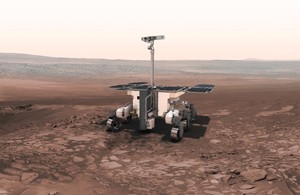Rosalind Franklin Mars rover passes latest tests ahead of September launch
The UK-built ExoMars Rosalind Franklin rover is set for launch in September after a series of successful tests, including driving off its landing platform.

Artist Impression of Rosalind Franklin. [Credit ESA]
The European Space Agency (ESA) rover starts the year with months of successful maintenance and functional tests behind it. All its instruments are go for flight, with some minor tuning left to complete this month.
Sue Horne, Head of Space Exploration at the UK Space Agency, said:
The Rosalind Franklin rover showcases some of the best of the UK’s space sector and its search for signs of life on Mars will inspire future generations of scientists and engineers.
It’s very exciting to see this flagship mission pass the latest tests and see the fruition of many years’ hard work as we look forward to the launch later this year.
The rover was built in Stevenage by Airbus, while the UCL Mullard Space Science Laboratory led on a key instrument known as the PanCam, a high-resolution 3D camera which will look at the terrain and rocks to try to detect signs of life.
The University of Leicester, Teledyne e2v and STFC RAL Space worked on the Raman Spectrometer which will use laser light to identify particular minerals and organic compounds and search for life.
Pietro Baglioni, ESA’s ExoMars rover team leader, said:
The rover is ready, and together with the recent drop test success for the parachutes, we are positive to be in time for the September launch date.
The Rosalind Franklin rover is currently in an ultra-clean room at the Thales Alenia Space premises in Turin, Italy, right by its travelling companion, the Kazachok landing platform. Following a final review in April, all the components of the spacecraft – rover, descent module, landing platform and carrier – will move to the launch site in Baikonur, Kazakhstan, to prepare for lift-off.
Following the nerve-wracking descent to the surface of Mars, a long-awaited moment in the ExoMars mission will be when Rosalind leaves the landing platform and drives onto the martian soil for the first time.
In preparation for this, the twin of the Rosalind Franklin rover successfully left the platform during recent tests in a Mars terrain simulator at the ALTEC premises in Turin.
While the driving during these exercises takes about 15 minutes, the whole process will last a few Martian days. After landing, the rover will be busy for over a week unfolding its solar panels, wheels and deploying the mast, among other checkouts.
The ExoMars twin rover, until now known as the Ground Test Model, has a new name: Amalia, named after Professor Amalia Ercoli Finzi, a renowned astrophysicist with vast experience in spaceflight dynamics.
Amalia was the first woman to graduate in aeronautical engineering in Italy, and besides serving as a scientific advisor for ESA and NASA, she designed the drill on Rosetta’s lander Philae and strongly pushed for the development of the ExoMars drill 20 years ago.
Engineers are using the Amalia rover to recreate different scenarios and help them take decisions that will keep Rosalind safe in the challenging environment of Mars. The model is fully representative of what the rover will be able to do on the Red Planet.
Amalia has so far demonstrated drilling soil samples down to 1.7 metres and operate all the instruments while sending scientific data to the Rover Operations Control Centre (ROCC), the operational hub that will orchestrate the roaming of the European-built rover on Mars.
The ESA-Roscosmos Trace Gas Orbiter is waiting for the arrival of ExoMars to the Red Planet. In addition to its own science mission, the orbiter relays data from NASA’s Perseverance rover.